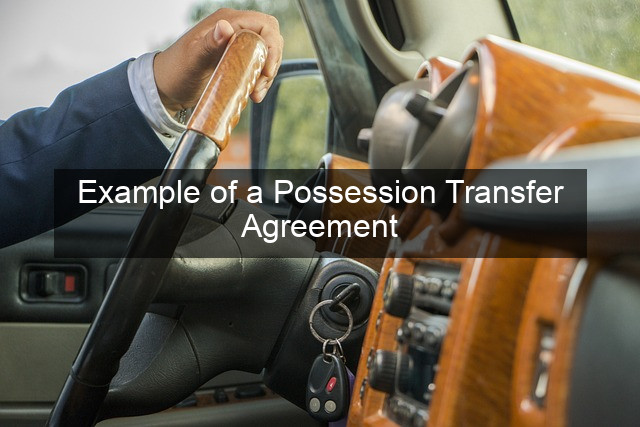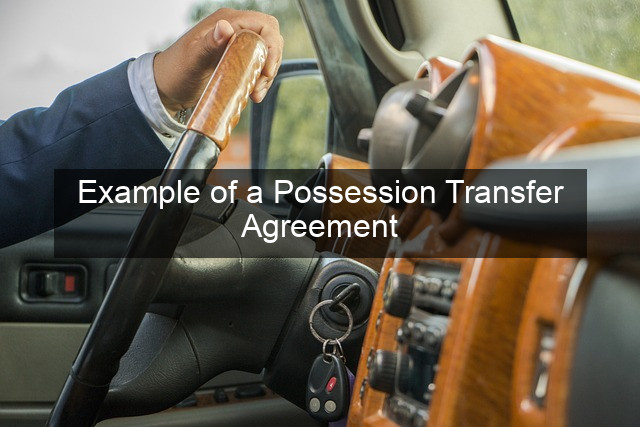Example of a Possession Transfer Agreement

- Example of a Possession Transfer Agreement
- Example of a Possession Transfer Agreement
- Understanding Possession Transfer Agreements
- What is a Possession Transfer Agreement?
- Key Components of a Possession Transfer Agreement
- Different Types of Possession Transfer Agreements
- Example of a Vehicle Possession Transfer Agreement
- Parties and Vehicle Information
- Terms and Conditions
- Payment and Other Considerations
- Conclusion
- Frequently Asked Questions

Example of a Possession Transfer Agreement
Transferring possession of property, whether it’s a car, a house, or even intellectual property, requires a legally sound agreement to protect all parties involved. A well-drafted possession transfer agreement clearly outlines the terms and conditions of the transfer, minimizing the risk of disputes and misunderstandings down the line. This document serves as a roadmap, guiding both the transferor (the party giving up possession) and the transferee (the party receiving possession) through the process. It ensures a smooth transition and provides legal recourse should any issues arise. This article will delve into the specifics of a possession transfer agreement, providing a practical example and explaining the key elements that should be included.
Understanding Possession Transfer Agreements
What is a Possession Transfer Agreement?
A possession transfer agreement is a legally binding contract that formalizes the transfer of possession of an asset from one party to another. It doesn’t necessarily transfer ownership, but rather the right to use and control the asset for a specified period or under certain conditions. This agreement can cover a wide range of assets, from tangible items like vehicles and real estate to intangible assets like intellectual property rights.
This agreement is crucial for establishing clear expectations and responsibilities. It protects both parties by outlining the terms of the transfer, including any payment schedules, conditions for return of the asset, and liabilities associated with possession.
Without a formal agreement, disputes can easily arise regarding the terms of the transfer, potentially leading to costly legal battles. A well-written agreement provides clarity and security for everyone involved.
Key Components of a Possession Transfer Agreement
Several key components are essential for a comprehensive and effective possession transfer agreement. These elements ensure clarity and protect the interests of both parties. Identifying and addressing these components is crucial for a legally sound agreement.
Firstly, the agreement should clearly identify the parties involved, including their full legal names and addresses. Secondly, a detailed description of the asset being transferred is necessary, including any relevant identification numbers or specific characteristics. This helps avoid ambiguity and ensures that both parties are aware of the exact asset in question.
The agreement should also specify the effective date of the transfer, the duration of the possession, and any conditions for the return of the asset. Finally, outlining the responsibilities of each party during the period of possession, such as maintenance and insurance, is crucial for preventing disputes.
Different Types of Possession Transfer Agreements
Possession transfer agreements can take various forms depending on the specific asset and the nature of the transfer. Understanding these different types is crucial for selecting the appropriate agreement for your specific needs.
For instance, a lease agreement is a common type of possession transfer agreement for real estate, granting the tenant the right to possess the property for a specified period in exchange for rent. Similarly, equipment lease agreements allow businesses to use equipment without outright ownership. These agreements often include clauses regarding maintenance and repair responsibilities.
In the context of intellectual property, a licensing agreement grants the licensee the right to use the intellectual property under specific terms and conditions. These agreements often define the scope of use, royalty payments, and the duration of the license. Choosing the right type of agreement is crucial for ensuring a smooth and legally sound transfer of possession.
Example of a Vehicle Possession Transfer Agreement
Parties and Vehicle Information
This agreement is made between John Smith (Transferor) and Jane Doe (Transferee) regarding the transfer of possession of a 2018 Honda Civic, VIN number 123456789. John Smith resides at 123 Main Street, Anytown, USA, and Jane Doe resides at 456 Oak Avenue, Anytown, USA. This information clearly identifies the parties and the specific vehicle involved in the agreement.
The vehicle is being transferred for a period of one year, beginning on January 1, 2024, and ending on December 31, 2024. The purpose of this transfer is for Jane Doe’s personal use. Clearly stating the duration and purpose of the transfer prevents misunderstandings and sets clear expectations.
Upon the expiration of the agreement, Jane Doe will return the vehicle to John Smith in the same condition it was received, barring normal wear and tear. This clause protects the transferor’s interest in the vehicle and ensures its proper return.

Terms and Conditions
Jane Doe will be responsible for all routine maintenance and repairs of the vehicle during the possession period. This includes oil changes, tire rotations, and any necessary repairs due to normal wear and tear. This clarifies the responsibilities of the transferee regarding vehicle upkeep.
Jane Doe will also be responsible for insuring the vehicle during the possession period. Proof of insurance must be provided to John Smith before the transfer of possession takes place. This clause protects both parties in case of accidents or damage to the vehicle.
Any modifications to the vehicle must be approved by John Smith in writing. This clause prevents unauthorized alterations that could affect the vehicle’s value or performance.
Payment and Other Considerations
Jane Doe will pay John Smith a monthly fee of $500 for the use of the vehicle. Payments are due on the first of each month. This clearly establishes the financial terms of the agreement.
In the event of an accident or damage to the vehicle, Jane Doe will immediately notify John Smith. The parties will then determine the appropriate course of action regarding repairs or insurance claims. This ensures timely communication and cooperation in case of unforeseen events.
This agreement constitutes the entire understanding between the parties and supersedes any prior agreements or understandings, whether written or oral. This clause clarifies that the written agreement is the final and binding document.
Conclusion
A possession transfer agreement is a vital tool for protecting the interests of both parties involved in the transfer of an asset. By clearly outlining the terms and conditions, responsibilities, and payment schedules, it minimizes the risk of disputes and ensures a smooth transition. Whether transferring a vehicle, real estate, or intellectual property, a well-drafted agreement provides clarity, security, and legal recourse. It is always advisable to consult with legal counsel to ensure the agreement is tailored to your specific needs and complies with applicable laws.
Frequently Asked Questions
What is the difference between possession and ownership?
Possession refers to the physical control and use of an asset, while ownership refers to the legal title and right to dispose of the asset.
Do I need a lawyer to draft a possession transfer agreement?
While not always required, consulting with a lawyer is recommended to ensure the agreement is legally sound and protects your interests.
What happens if one party breaches the agreement?
The non-breaching party can pursue legal remedies, such as seeking damages or specific performance of the contract.
Can a possession transfer agreement be terminated early?
Yes, if the agreement includes provisions for early termination, or if both parties mutually agree to terminate the agreement.
What should I do if I lose the possession transfer agreement?
It’s advisable to keep multiple copies of the agreement. If the original is lost, a copy can be used as evidence of the agreement.
| Element | Description |
|---|---|
| Parties | Names and addresses of transferor and transferee |
| Asset | Detailed description of the asset being transferred |
| Term | Duration of the possession transfer |
| Payment | Agreed upon payment terms |
- Always clearly define the asset being transferred.
- Specify the duration of the possession transfer.
- Outline the responsibilities of each party.



